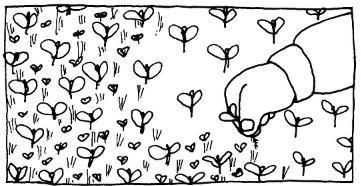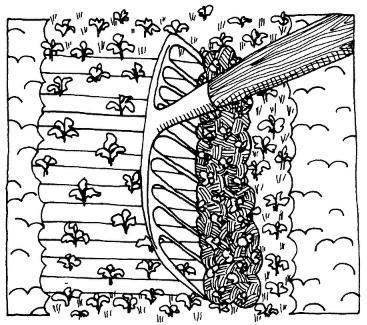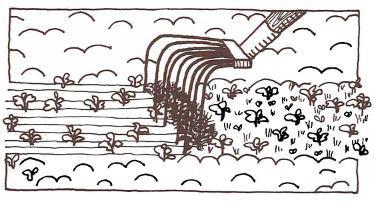Three essentials to a healthy crop of roots is thining, weeding, and watering.
The First ThinningThinning is a must with root crops. Crowded conditions cause them to become stunted or twisted around each other, and that's not good. You have to thin if you want roots that are big enough to eat. Starting when the seedlings are approximately 1/4 to 1/2 inch tall, you can thin by hand or use the simple but effective iron-rake method.
Thinning with a rake is a snap. Just pull an iron garden rake once across the row with its teeth going into the soil about 1/4 inch. The teeth are spaced at intervals to catch just enough seedlings, pulling them from the row. Don't look down as you're doing this -- it's a horrible sight. You may think you've destroyed the whole row of plants, but don't fret. The remaining ones will perk up in a day or so. You can thin a single row this way, too.
Raking also cultivates the soil, stirring up and killing "weedlings." Most young weeds haven't had time to develop a deep taproot, so this initial thinning will dislodge them before they come up, exposing their shallow roots and killing them. Some of the worst garden weeds (pigweed, lamb's-quarter and many others) have very strong taproots, and the idea is to catch these weeds before they put down deep roots.
By thinning with a rake, you also break any crust on the surface, aerating the soil at the same time.

You can thin by hand if the rake technique seems a little too drastic. Simply pull up enough plants that the remaining ones will stand one to two inches apart. You may not trust the rake method at first, but try it on at least part of a row. With the rake you can thin (and weed) all your root crops in just a minute or two, whereas thinning by hand seems to take forever.
The best time to thin is a few hours after a rain or a thorough watering, when the soil is damp but the plants have dried off completely. (Never weed, thin or harvest around wet plants, because you can spread disease from your hands and clothing without knowing it.) Damp soil permits seedlings to be pulled without disturbing the roots of the remaining plants, and any weeds that start to germinate after a rain will be uprooted, too. If it's very dry on the day you decide to thin, water the surface of the soil, so you don't pull up more seedlings than you intend.
Because beet seeds produce clusters of seedlings, the simplest way to thin them is with an iron rake. The rake teeth will uproot just the right number of seedlings. If you thin by hand, don't try to remove any of the seedlings from within a single cluster. It's too easy to disturb the remaining ones. Instead, pull up whole clusters, leaving two to three inches between them. If you like beet greens, sow the seeds a little thicker than is usually recommended on seed packages. When the beets are a little bigger, thin them again; along with the greens, you'll also get a great harvest of marble-sized baby beets.
Thinning always seems more traumatic for the gardener than it is for the plants. People don't like to pull up those helpless seedlings that have just barely made it through the soil surface. Think of it as helping your whole crop and giving you more food to eat, and it will soon be a natural part of your garden routine.

Most root crops grow very slowly the first few weeks, and they can't compete with weeds. But there are several time-saving ways to stay ahead in the weeding game.
Try this trick in the early spring before you even plant a seed: Wait a week or so between the initial soil preparation and planting day. During this time, go out several times and till or stir the soil. This exposes and kills the first batches of tiny "weedlings" lurking near the surface that may try to overrun your young seedlings.
Once your plants are up, you should stir up the soil within the rows every four or five days until the seedlings are well established. You can save a lot of bending over by using special hoes for weeding. Many have a strong, narrow blade with a curved gooseneck to let you pull weeds from even tight spots in the row without damaging the stems or roots of vegetables.
Once the plants get too tall to use a weeding tool, buckle down and hand pull every weed as soon as you see it. Keep in mind that any weed that grows in your garden is a robber, stealing sun, water and food from your crops, and in the end, stealing food from you.
To keep down weeds between the rows, stir the soil surface there, too. Or, you can put down a two- to three-inch layer of mulch (shredded leaves, straw, lawn clippings or even newspapers) between the rows to do the work for you. Mulch has the added advantage of keeping the soil moist and at an even temperature. Your root crops will really appreciate this.
Naturally, the more weed prevention you can accomplish early, the easier it will be later on. And by planting in wide rows, you'll have very little hand weeding to do. But you're bound to get some weeds, so go out to your garden daily and keep them pulled!

Thin again by hand several weeks after the first thinning to give the remaining plants space to reach their mature size. (Enjoy the thinnings of these sweet, tender "baby" carrots and beets.) This is also when you would harvest the radishes planted as companion plants. In heavy soil, leave the White Icicle radishes until they're quite large, then pull them to create that beneficial void in the soil. The beets, carrots, parsnips or turnips left in the row will push the soil around them into the gaps as they grow.
The third time you go out to thin, you'll be harvesting for real. See how you can kill a few birds with one stone, as each chore combines with the others?
WateringRoot crops need about one inch of water per week. If you can supply this water evenly, with no long dry spells to inhibit the growth of the roots and greens, you'll encourage a healthy crop. The exception to the one inch per week rule of thumb is the light sprinklings you should provide after sowing the seeds and until the seedlings emerge. Once the seedlings are up, return to the following watering habits:
Water when your garden needs it, not just by a calendar schedule. Don't be tempted to water your plants if the greens are drooping occasionally in the late afternoon sun -- this is normal. But, if they look wilted before eleven o'clock in the morning, they need water.
Another mistake gardeners often make is to give their gardens many light waterings instead of a few thorough soakings. Once your seeds are sprouted, soak the soil when it needs it to a depth of four to six inches. By watering deeply you encourage the taproot to grow down seeking the moisture. Shallow waterings promote shallow root growth, which is exactly what you don't want, especially if you live in a drought-prone area.
How much does it take to water your garden to a depth of four to six inches? If you're using a sprinkler, set a pan in the area you're watering. When the water is an inch deep in the pan, the nearby soil will be sufficiently soaked-about six inches down.
 Victory Seed Company has all the seeds you want for your best garden in 2024.
Victory Seed Company has all the seeds you want for your best garden in 2024.
For 25 years, the family-owned Victory Seed Company has provided the highest quality vegetable, herb and flower seeds to families across the country. We are passionate about providing you the best seeds available that give excellent germination, robust plants, and the harvest you want. With a catalog of over a thousand varieties, we have everything, and our prices are the kinds that we'd want to pay. We have hundreds of yesterday's heirloom vegetables, as well as today's award winning hybrid selections. Get to know us by visiting our website and browsing through our online vegetable seed catalog.
| 1. Growing Root Crops ← you're on this article right now |
| 2. Root Crop Problems |
| 1. Growing Root Crops ← you're on this article right now |
| 2. Root Crop Problems |